Currently only excerpts & illustrations from the last 13 issues
(numbers 43 to 55) are on this site.
Scroll down to view the February 2000 issue. Click on the numbers to view other issues.
Info about the current book on the arts
|
 |  |
 A listing of the contents 1992 - 2002 >> (numbers 19 - 59)
A listing of the contents 1992 - 2002 >> (numbers 19 - 59) |
Contents List |
 |
excerpts & illustrations
(The full articles are only available in the printed magazine. Click on "subscribe" for more info.)
|
number 51
February 2000
News & Letters
pages 2 - 6
2001 Anthology : Poets Take a Long View
Kalimat Press, in cooperations with Bombshelter Press (Los Angeles), will publish an anthology of poetry and prose that confronts the millennium in the Fall of 2000. The editors are asking poets and writers to take a long view--to contemplate the last thousand years of human history, or the next thousand, or both. Bahá´í poets are especially encouraged to submit their work.
Deadline for submissions: April 30, 2000. Email KalimatP@aol.com for more information.
|
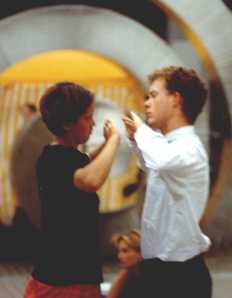 Awake Dutch Bahá´í Dancegroup
Awake Dutch Bahá´í Dancegroup
photograph by Matin Koree,
The Netherlands.
|
 Los Nice Guys Los Nice Guys
Check out this music by the Bahá´í Group, Los Nice Guys at www.losniceguys.com. There are song excerpts in Flash and MP3. Most lyrics, by
Larry Magee, are in English. Others are in Spanish. Order these music cassettes
(Buddhist, Baptist, Catholic, Jew (1996); The Wilderness, The Mountain (1997); Los Nice Guys III(1998) ) from
Larry Magee, 16311 Canyon Shadow, San Antonio, TX 78232, U.S.A., tel: 210-491-9836,  email: larry_magee@hp.com email: larry_magee@hp.com
Sombol - The Other Wing
Order this Music CD by the Persian-New Zealand singer /songwriter, Sonbol Taefi at: EchoMusic, P.O. Box 38-790, Howick, Auckland, New Zealand. Email Sombol for more info at: sonbol@voyager.co.nz
Housman’s Peace Diary 2000 & World Peace Directory
The 47th edition of the Peace Diary, a non-profit-making service to movements around the world working for peace, social justice and the preservation of our ecosystem. The book contains addresses of organisations in 170 countries. Each book costs: £6.95, CAN$ 9.95 or US$ 7.95. For more info contact: Housmans, 5 Caledonian Road, London NI 9DX, U.K. or call NSP free 1-800-567-6772 or surf to: www.newsociety.com
|
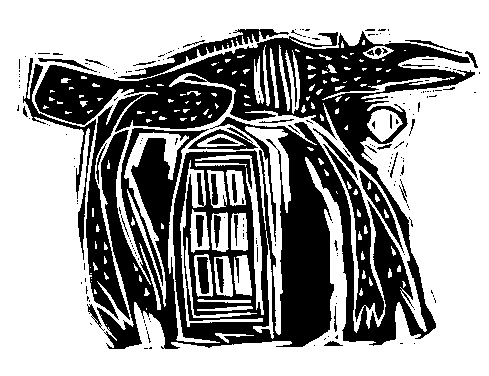
Ciosg Talysarn (Talysarn Telephone kiosk) woodcut by William Brown in March,
a book of poems (in Welsh with English translations) by David Greenslade.
|
Pages 2 to 4:
Letter from Valerie Senyk, Canada.
I live in Sudbury, Ontario, where I teach theatre at
Laurentian University. I am also a published and performance poet. I do not think that poetry could not sound like prose, or that free verse is not poetic. But I think there are standards that need to be looked at. Crystalized images and ideas nourish me more as a reader/listener than non-crystalized.
|
For an example in a poem by Yeats: "turning and turning in the widening gyre/ the falcon cannot hear the falconer." He might have written, instead: "The falcon can't hear the falconer as he flies in a spiralling motion..."
Or perhaps another, say T.S. Eliot: "We are the hollow men/ We are the stuffed men/ Leaning together/ Headpiece filled with straw." Although this line sounds more prosey, it is the choice of language and line-scan that crystalizes it, so that it doesn't sound like "We are men without souls and not a single original thought in our heads." I don't know if these are good examples.
I don't want to sound trite about this and I can't say that my views on this represent the views on poetry in my part of the world. In fact, here, anyone who wants to call him/herself a poet can do so by scribbling any drivel down so that it might look like poetry, and be rewarded for it. I think poetry's going through a bad time right now. I am not conservative or dogmatic or anal-retentive by any means, but I do long for some standards in the arts. Not the above sort, but at least a stick set up at a certain level that indicates what one should strive for.
|
Letter from Tony Lee, U.S.A.
I agree that there must be standards in the arts, in the sense of a goal to strive for at least. But, I am not sure that these standards should have anything to do with form, at least in poetry.
The people that I am in touch with who do poetry in Los Angeles are completely unconcerned with form. But they certainly have standards for what separates a good poem from a bad one. We never talk about this stuff explicitly because ... well, I guess that it is just too hard to define. But, the standard seems to be the effectiveness of the poem, regardless of the subject, what it says, or what form it takes. Does the poem convey an emotional message that is intense and effective? Does it change your mood? Does it affect you spiritually? Does the poem draw you into its consciousness and stay with you? (Stuff like that.)
|
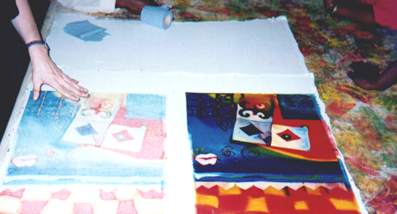
The Batik Lesson, photograph by Margaret Nagawa, Uganda/U.K.
|
Questions of whether the thoughts are crystalized, or whether the poem conforms to a certain form are thought of as irrelevant. Well, maybe not completely, because there is a very strong bias towards ordinary language. That is, that the language of contemporary poetry is the language of ordinary speech -unless you deliberately depart from that for some intended effect.
So the challenge here in poetry is to aim for an intense emotional communication through normal words and speech patterns. The publications of the group (Spillway, ONTHEBUS, etc.) have a lot of confessional poetry and even some prose. No one makes much of a distinction between poetry and prose. Good writing is just good writing. Judged by its spiritual impact, I suppose.
Women and Music, Letter from Sean Manning, New Zealand.
The early Irish church, according to Thomas Cahill, followed Patrick's rather un-Roman practice (though a Romanised Celtic Briton, his education was mercifully interrupted by slavery at the age of eight, and he never caught up of giving women the status they had in pre-Christian times. Pat was never concerned about the sins of the flesh, instead he railled against violence and slavery and had a keen sense of justice. There was no fear of sexuality, and women were not seen as particularly inferior. That they were not equal was just because they tended to come off worse in a fist fight, though there were some notable exceptions, from Mebh, queen of Connacht about the time of Christ, to Grainne, chieftainess of Achill in Elizabethan times. ...Despite more successful subsequent invasions by the Normans, the Stuarts and so forth, the Irish character, out on the European fringes, remained intact for longer and Irish women still retain a penchant for a punch up in times of stress, while their English sisters embraced the veil and eventually high heels and pushup bras, which makes boxing, sword fighting and singing really difficult. This may account for the prominence, of women in Irish traditional music (especially sean nos singing), as well as the presidency and the IRA.
In New Zealand, Maori women dominate when it comes to waiata (singing), and are a powerful presence in many forms of haka (ed. a dramatic song/dance performance). Unfortunately, the European society here was founded, and is still based, on the old imperial principles so gleefully exploited by the last thousand years worth of the British, including the inferior place of women. So when men waving some sort of instrument mount the stage we are overly tolerant, while women are regarded as needing encouragement, support, affirmation, and positive feedback, and are seen as pushy if they don't. Again, there are some notable exceptions, but I won't name them because they're still living.
|

CD cover,
Love Setteth the World Aflame
by Roya Bauman, U.S.A.
|
Letter from Roya Bauman, U.S.A.
Recently at the Downtown United Presbyterian Church in Rochester, New York, (where my husband George and I have singing jobs), several Bahá´í songs were featured as part of the sermon. The sermon was about how religious faiths use poetic language in expressing religious/spiritual thoughts and teachings, and how such language can be uplifting and transformative. The speaker addressed not only Christianity but also Judaism, Islam and the Bahá´í Faith; she also quoted Rumi, the Persian poet. She had heard my CD at a friend's house and decided to interweave 3 of the songs into her sermon. George and I, with help from choir director John Bodinger, performed the following songs, all composed by Anne Biswell of Kansas City: O God Guide Me!, The Healing Prayer, Home of Peace. In the church bulletin, each song was listed along with its author (Baha'u'lláh or ‘Abdu'l-Bahá or "text unauthenticated") and the composer.
You can order my CD, "Love Setteth the World Aflame",
at the following web site: www.dynrec.com/royabauman,
or via e-mail at baumanroya@aol.com |
Letter from Eugene Smith, Canada
As directed by our Bahá´í Council, our Assembly was asked to ensure that artists were involved in our community's festival, not only in the program but in the planning. We are favoured in this area with some world-class performers -Caroline MacKay, Spirit Village, Auberte Campeau, Farideh Tavakoli and Isabelle Charland - some very talented visual artists - Margo Styan and Wayne Powers - a group of wonderful Persian dancers, the Skrenes (a family in fact), and the newly resurrected Youth Dance Workshop (kind of a next generation thing). There is also a Bahá´í artists' group being started in this region (Okanagan Valley, British Columbia) which REALLY helped to get things integrated, so that the program was a feast for the heart, soul and mind.
The foyer of the facility (the community theatre) was adorned with visual art work from area artists, so that when you arrived you saw and felt beauty as well as the smiling faces of old friends and new. The devotions incorporated music, poetry and chanting of the sacred verses. The first talk was interspersed with live performances of songs that demonstrated or reinforced aspects of the talk on the covenant...
We then experienced Caroline MacKay and Isabelle Charland with their dramatic presentation 'Lua Getsinger, Herald of the Covenant' with the readings taken from the book of the same name. This was followed by the Skrenes family dancers and the Youth Workshop. To be quite honest, no matter how many times I see the "drug dance" or the "racism dance", I weep. The power of all these presentations say so much. Yes, we need to speak but we also need to act (out) engage the hearts and stir the emotions of the Kingdom- something that the vehicle of expression that we have as artists allows.
After a dinner break, we were treated to the 'Mystic Bride' a selection of readings from the Hidden Words chanted in Persian by Farideh Tavakoli and in English by Wayne Powers with the theme that the Beloved is calling all of His beloved! To round out the day, the musicians had set the stage in an Irish parlour format (a semi-circle with all the musicians present). There followed a host and wonderful array of original songs, traditional songs and poetry and Writings. The poetry of Roger White with his sweet humour was read; we went "Over the Sea to Skye" with Caroline; we were in the "Black Pit" (so to speak) with Spirit Village; and to end, we all finished with the song "Fort Tabarsi" (written by Jeannie Murday), so that the last words in the Festival were Ya-Baha'u'l-Abhá!
Dance, Music and Drama Course, India.
This course took place for 2 weeks in May 1999 at the Bahá´í Academy in Panchangani. Twenty-three Participants came from six states of India, from Nepal, Malaysia, Ireland and Tajikistan. The curriculum consisted of intensive training in drama, music and dance on selected Bahá'í themes. A script for the play, "Communal Harmony, The Greatest Challenge", was developed and performed. It told the true story of a Bahá´í youth facing fanatical reactions from his relative ot his newly found faith, along with resistance to his intercultural marriage. The play incorporated lively dialogue and action with live music. Music sung in English and Hindi was developed for choir and solo performances. The dance workshops focused on overcoming predujice as their main theme.
There were also workshops and lectures on the Bahá´í Writings and the Arts and related topics as well as
video showings of Bahá´í concerts and congresses. The course finished with a public concert in the main hall.
The Green Lake concert
by Kathy Tahiri, U.S.A.
It was the 40th anniversary of this annual conference at Green Lake, Wisconsin, the oldest of any regional Bahá´í conference in the US, as I understand it, and it was my very great bounty to be part of it. Notices about the plan to have a choir for the conference appeared in national and local Bahá´í publications as well as on a couple of on-line Bahá´í lists and was spread through word of mouth. The conference theme was "O Ye Companions of the Crimson Ark", and so, the choir was dubbed the "Crimson Ark Choir". About forty-two singers signed up, ten of which were from the Chicago area and members of the House of Worship choir, the rest were from all over the mid-west. There was no auditioning, the attitude was one of "come enjoy." Fortunately the choir was blessed with a fairly even distribution, parts-wise, of voices. We tried to get some "names" to collaborate in the effort, but it just didn't materialize. Perhaps another year, Inshallah!
|
Music and practice tapes were mailed to the singers at the end of July, so they had about a month to learn their parts.
Many of the singers were able to arrive at the conference venue Thursday evening or very early Friday morning, in order to begin rehearsing and deepening Friday morning. The rest trickled in as the day went on, until we had the full complement. Green lake festivities normally start Friday afternoon and evening, so this was a very special effort and sacrifice made by these loving souls. And they had done their homework well. The choir rehearsed most of Friday and Saturday, with performances on Friday night, Saturday night, and Sunday morning. The theme for the Friday night program was "Folk Songs
from the Americas" and all the pieces reflected some sort of folksy style found in North and/or South America. We invited the audience to sing along on the pieces they knew. We did "O Lord, My God", a prayer not revealed in the form it is in, but whose phrases nevertheless can be found throughout Bahá'í Writings and the Bible. This piece begins simply with a cappella voices in unison, and gradually unfolds as an echo piece in duet and then in five parts, then blasts into a rock/gospel incarnation. It was wonderful!
Then we premiered a new piece, "Bendito Es El Sitio", or "Blessed Is the Spot" in Spanish, in a soft, gentle Hispanic ballad style (by Bud Humphrey). From there, we sang a shining example of artistic unity in diversity, combining element from five very diverse cultures -we titled it "Native American Invocation", which uses a Native American style chant of the Arabic "Ya Baha'u'l-Abhá" and "O God, My God" (in English), sung in unison, in octaves, and in harmony using a pentatonic (Asian) scale in Western style voice parts, and accompanied by an African drum. Then we did an exuberant Southern
gospel style piece called "Glory Be", and ended with the great rhythm & blues gospel favorite, "In this Day Baha'u'lláh", and were blessed with members who could improvise beautiful additions in the fast "in this day" sections, which of course, brought the audience to its feet!
|
|
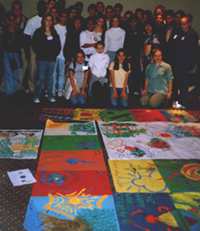 |
Arts Workshop
at the 1999 Hague Appeal for Peace,
conducted by Claudia v. Both, Germany and Nadi Hofmann, Czech Republic.
The Future Vision Mural Painting Workshop began with mixing youth from many organisations into groups of about 5-10 people. Each of these groups gathered around coloured sheets of paper that were attached to each other. Markers, paints and paintbrushes were provided. While calm music was played in the background, the following instructions were given to the groups: "Please demonstrate your vision of a world in which you would like to live. You may either draw your ideas or express them in writing."
|
After 30 minutes of drawing and painting, the participants were asked to rotate and change their groups in order to look around at what other youth had painted or written and maybe to add or comment on this. After another 20 minutes, the sheets were joined in the centre of the room and the participants gathered around their murals standing in a circle. Amongst other things, they saw everybody's desire for better co-operation of the human race, for a clean environment, for the abolition of prejudices, for the beauty in the world, for happiness, for a better integration of children, old people and disabled people.
After this, they were given the following instructions: "Please think about all the obstacles that are preventing us from realising these visions. Write each obstacle on one sheet of A4 paper and put these on the murals." During this part of the activity, the music changed from calm and to aggressive.
Gradually the murals were covered by obstacles such as prejudice, fear of change, poverty, lack of communication, violence, wars, envy, selfishness, anger, greed, lack of respect and so on.
For the third part of the session, calm music was again played. All participants stood in a circle around the murals. The following instructions were given: "What we will do now is very quick and will show you that these obstacles can quite easily be removed with the participation of every one of us. Everyone will pick up one of these obstacles, read it aloud and express the desire to abolish it. For example: the instructor lifts up one of the sheets and says "No more wars!", then crumples it and throws it into the garbage bin that is being passed around."
One by one every obstacle was picked up and thrown into the plastic bag, while every participant expressed his or her desire for this obstacle to be removed. In the end, the peace murals were again uncovered and all the participants clapped.
|
...Saturday night, we had to cut almost half of our program. All the speakers were running overtime, and so the choir was told quite firmly not to run overtime in our presentation. So in an effort to be obedient, we cut our least well known pieces.
Our theme was "The Crimson Ark Sails Around the World". Our songs were done in pairs - connected by religion, geography, language and/or history, one honoring an older culture, and the other a similar aspect of the Bahá'í Faith. We started off with the beautiful Hebrew prayer, "Avinu Malkeynu", and paired it with the Persian, "Allahumma". We next traveled to Africa with "Siyahamba" and "Baha'u'lláh Ikame". We crossed oceans to North America by way of Europe, to present two of ‘Abdu'l-Bahá's favorites, "Nearer, My God, to Thee" and Louise Waite's "Benediction". We continued westward across the Pacific to India, with Gustav Holst's "To the Unknown God" from his choral Hymns from the Rig Veda, paired with "Ravi Shankar's "O My Servant", done partially in Hindi and partially in English. We had also planned to visit Buddhism and Asia with a piece on a Buddhist text and a Hidden Word in Japanese, and to return to the Holy Land with the Báb's Prayer for Protection (composed by Jill Simon of Remembrance ensemble ) and a festival piece on the Ridvan tablet, but these will just have to wait for another time. We ended Saturday night's program with a lively round, which we taught the audience to sing, and then capped it off with a version of the piece in four part harmony, to shouts of "encore!" (but we were out of time).
On Sunday, we presented the prayer "O Thou Whose Face (is the object of my adoration)" in a contrafaction of a beautiful piece by Franz Biebl (seven part harmony, in antiphonal style) and then later presented the exuberant rock'n'roll song "Fanfare for the New Day". We thought we had finished our program but were told to stay as Jerry Johnson led a couple of lively sing-along pieces, and then we all ended up singing "Ya Bahá'u'l-Abhá" again.
It was a bounty beyond compare for me. The singers were warm and friendly, and did a beautiful job of blending and balancing their voices into a glorious whole and finessing each piece just so to convey the richness and meaning of each piece. We received lots of lovely comments - how people were "taken back" to their roots or their homes by this or that piece I was permitted a glimpse of Paradise. |
Artist Profile
pages 6 - 8
Nancy Harrris, entertainment agent, musican, U.S.A.
|
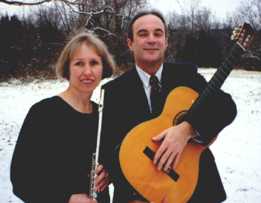
Silverwood,
Nancy Harris and John Grammer.
|
My current involvement in music takes on many different flavors. My main job is that of owner and president of an entertainment agency, Harris Entertainment. This is a small company consisting of my husband Sam and myself, plus a recently added part-time agent.
We book commerical engagements for individuals, associations, and corporations. This can include wedding ceremonies and receptions, military reunions, retail store promotions, street festivals, trade shows, holiday parties, retirement home dinners, fund-raisers,
and a host of other events. We also place individual musicians in back-up orchestras for national acts as well as touring Broadway shows which play in the area (Sam's forte with the agency). We've been doing this since the early 1980s.
|
Another part of my musical involvement is playing flute. I graduated from the University of Louisville in Louisville, Kentucky, USA, with both bachelor's and maser's degrees in music education, flute emphasis (1967 and 1978). My current mainstay of musical performance is my flute and guitar duo Silverwood. Silverwood began as a purely classical ensemble. Through the years I've had several different guitarists. We would dabble in pop music (standards, from the Beatles to Cole Porter), filling occasional requests for weddings, but we mainly stuck to classical.
|
During this time I also played with a Celtic band called Tight Squeeze. I was with Tight Squeeze from 1985 when the band formed until 1992. Originally the band was keyboard, accordion, guitar, and me. After a year or so, the keyboard player moved across the country and we performed as a trio for a while. I played silver flute and soprano recorder, eventually adding pennywhistle. We decided we needed a fiddle and found an excellent one who was classically trained and had never played Celtic before. He was a quick study. In 1988 we made our first and only recording, a self-titled work which featured very traditional Irish and Scottish tunes. Jigs, reels, strathspeys, and waltzes. We did the entire album in one six-hour recording session, something I wouldn't recommend to anyone. |
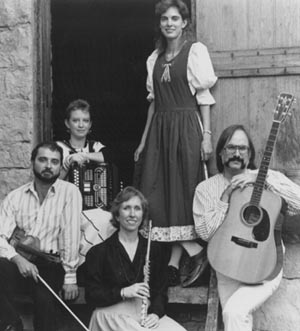
Tight Squeeze,
Nancy Harris is holding the flute. |
...I also recently acquired an Indian courting flute. I admit my fascination with this flute came from hearing and watching Kevin Locke play. Kevin has performed in Louisville several times and we were fortunate enough to have him stay at our home. We had a delightful time sharing music with him.
We enjoy playing together for various Bahá´í functions in our community. Earlier this year, when our community began having monthly unity feasts, we thought it would be fun to have a variety of music to complement the readings from various Holy Scriptures. We had four selections mixed with the Bahá´í, Christian, Native American, Islamic, and Jewish readings. We began with a flute and guitar rendition (Sam plays guitar for pleasure) of the Christian song "Let Us Break Bread Together." We followed it with the Bahá´í tune "Man of Persia" which we learned in the late 1960s. Then a self-composed tune on the Indian courting flute. We finished it with an old American West love song called "Spanish is the Loving Tongue." We played that on accordion (the first instrument I ever learned) and harmonica (the first non-percussion instrument I ever heard Sam play).
|
pages 9 - 11
Omid Aazami, dancer in the Awake Dutch Bahá´í Dancegroup, The Netherlands.
|
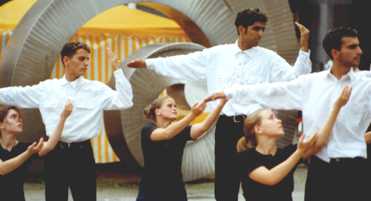 Omid Aazami is standing on the left. Omid Aazami is standing on the left. |
The Bahá'í dance workshop, Awake, is a group of 14 to 16 youth who meet each month to deepen, consult and practice dances. I have been a member of the group for four and a half years. About five years ago I was asked to join the group, but I didn't want to until the day I saw how the group functioned. It was January 1995, and I went with a member to a practice. I watched how they consulted and practised a new dance. I even took part in it. I enjoyed that experience so much that I joined. I especially loved the spirit of the group. My first performance was four months later. It was performed in a square in Nijmegen for a small festival, and was very successful.
|
At the time, I was not very concerned about dance, but since becoming a member, I have discovered that it is a good way to share Bahá'í principles with others. Our dances are based on the principles of the Faith. When I joined, we only knew the Black and White dance, so before the first tour in 1995 we created a few more dances - the Drugs dance, the dance about the equality of men and women, and an earlier version of the Poverty dance.
I've always been into music, but I never did anything like dance. I became a member more to teach the Bahá'í Faith, but then learned to enjoy dancing in a group...
|
Poems
pages 11 - 15
H a t s
That was where the hats were worn:
A black one for the beginning of the week;
Another, moon colored, for Wednesday
afternoons,
And for the holidays, a hat of pain
To give us sympathy for others.
by Robert L. Schwarz, U.S.A.
|
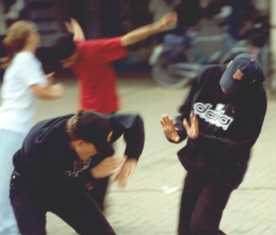
Awake Dutch Bahá´í Dancegroup
photograph by
Matin Koree, The Netherlands.
|
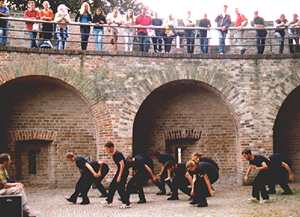
Awake Dutch Bahá´í Dancegroup
performing in Leiden, summer of 1999.
Photograph: Sonja van Kerkhoff, The Netherlands. |
northern
lights
ribbons of all colours
flutter suspended from night's
ceiling dancing like my sister dressed
in silken veils swirling poetic to sufi music
electromagnetic energy in the upper atmosphere
offers a holographic display of love from god
an aurora borealis for even the eyes of
night nesting hawks to behold
love pure dazzling love
by Cheryl Cudmore, Canada.
|
FROZEN RIVER
song lyric by Eric Chaet, U.S.A.
The river’s frozen over now --
Looks like it’s not going anywhere --
But I know that beneath the ice
It’s still making its way to the bay.
The river’s frozen over now --
Snow’s blown, sliding across the ice --
Hawk goes cruising, swooping --
The river, underneath, keeps making its way to the bay.
A thousand little rivulets & streams,
A million hopes & a million dreams --
Starting & blocked, & going around --
The river keeps making its way to the bay.
But it’s frozen over now --
Seems like everything we’ve tried has failed --
Seems like every good deed has been nailed to a cross --
But the river, underneath, keeps making its way to the bay.
The river’s frozen over now --
Looks like it’s not going anywhere --
But I know that beneath the ice
It’s still making its way to the bay.
|
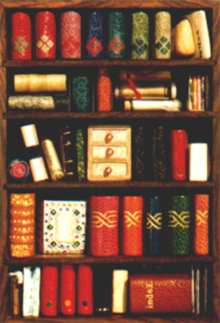
poème d'amour
en 50 tomes et 50 langues
(Poems of love
in 50 volumes and languages),
by Estelle Cabannes, France,
9,6 x 6,6 cm, 1988.
|
Táhirih
Bridal-white and calm
this was her hour.
"Yield or be death’s cold sister!"
And she:
"Beyond this point - no quest.
Beyond love’s talk - no tale."
For she would be victor
by the silk scarf she carried.
when the execution knot
would close the love’s halter home.
by Martyn Burke, Belgium.
published in, My Calamity is My Providence,
edited by Tahirih Khodadoust Foroughi, U.S.A., 1984. |
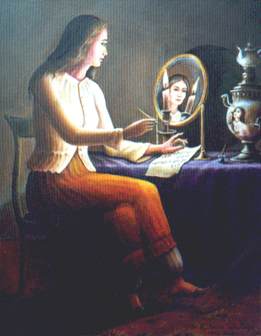
Tahirih composing poetry
by Pooria Sabetazm, U.S.A.
Oil on Canvas, 153 B.E., 1996.
14 x 16 inches.
|
excerpt from the poem:
Benediction
It was the plane circling at Idlewild
unable to land, unable to stay aloft,
that fell into the grace of Jamaica Bay.
It was early evening. Summer. The Fifties.
It was a neighbor's blue station wagon.
The noisy drive
to the beach....
by Peter E. Murphy, U.S.A.
first published in The Ledge, 1996.
|
excerpt from the poem:
In Memorium
for Robert Hayden
A thousand sterling hours
cleft for the single gold -
so Robert Hayden wrote -
so he lived -unending good things,
set aside for the excellent -
yearning placed in a vase out of Keats -
what is the yesterday he felt
but the crucial yes after no -
....
by Michael Fitzgerald, U.S.A.
from Songs for the Phoenix, published by George Ronald, U.K., 1994. |
THE THINNING
I. In my garden, long untended
I spend the morning thinning
rows of half-grown plants:
broccoli, cauliflower, cabbage,
too closely bound together.
Their bodies, tender and resilient,
yield to my insistent pull.
Work now hurried, as the sun creeps higher,
I have no regard for which plants might
be more perfect, might weather well this pruning.
Tossing the unlucky ones aside, with a careless
apology: Now the others will fare better,
I ignore the signs of coming maturity.
If they seek survival, I am unaware
and hear no cries as I carry the piles to the refuse heap,
leaving their roots exposed to the withering sun.
Satisfied, and looking back at the preened garden,
I go in and wash the dirt from my hands.
II. In Iran such savagery exists, though plants
are not the victims. Carelessly plucked from life,
it is the Bahá´ís who are thinned and weeded,
raped, humiliated, spit upon, burned:
a doctor here, a mother of four, a peasant.
Their bodies are obeisant, and yield without
complaint to this torture.
If they seek survival, if they ache for their loved ones,
the killers are unaware, and hear no cries as they
carry the bodies to the most convenient place to be dumped,
exposed to the mid-day sun.
Satisfied, the executioners move on, to wash their hands
not of dirt but of blood, proud of their labors.
But they do not know. The others left standing will be
stronger,
Will produce a harvest such as the world has not known.
Anne Gordon Perry, U.S.A.
published in, My Calamity is My Providence,
edited by Tahirih Khodadoust Foroughi, U.S.A., 1984.
excerpt from the poem:
visit: joan
she tells me
that when she is well
she visits the psych ward
shares cigarettes, listens, holds their shaking hands
in her apartment she reads
prays, takes her meds
checks herself in when her fear is too great
wednesdays she is not at home - on phone, no one at the door
wednesdays she is healing...
by Catherine Patrick, Canada.
|
pages 12 and 13
excerpt from:
Gigantic Violin
...
like me she's a GRINGA
and i think she's busking
not only for money but so that she
can remember her name and keep remembering
despite the howling buzz of this street
if she'll come away with me
we may find her name and mine in the grass
beautifully inscribed on grey stones
and she is coming towards me and i
am trying to cross the street to meet her but
just try to find your way
across a street shaped like a gigantic
violin
Janet Ruhe, U.S.A.

Detail of an illustration for the poem,
Gigantic Violin by Janet Ruhe
1999, ink, 42 x 29 cm
by Jacqueline Wassen,
The Netherlands
|
excerpt from the poem:
Millenium
For two thousand years we waited for the Messiah,
and the Messiah came.
He was arrested for disturbing the peace.
I watched.
We waited two thousand years for Christ's return,
and he came back.
But we found out he was homeless,
and we ran him out of town.
I cried.
We waited two thousand years for the avatar,
and Lord Krishna appeared.
But we thought he was a panhandler,
and we gave him money.
I gave three dollars.
We waited two thousand years for another Buddha,
and another was born.
But he didn't speak the language,
and we ignored him.
I apologized
...
by Tony Lee, U.S.A.
|
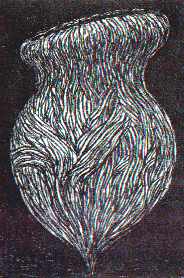
Decayed Gum Nut
1994, red chalk, 76 x 56 cm
by Peter Randall-Page, U.K.,
|
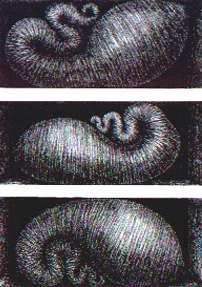
Underground
1994, charcoal, 75.5 x 56 cm
by Peter Randall-Page, U.K.,
|
Articles
pages 16 - 18
In mind of Botany: In the realm of the Senses
Paul Nesbitt in conversation with the sculptor Peter Randall-Page, U.K.
In the late 1980s you began working predominantly, although not exclusively, with plant forms. But you have been interested in natural forms (fruits, seeds, fossils) since childhood. Can you remember how your fascination first began?
I grew up in the country and always found the natural world deeply engaging. Later, through my work, I
became particularly interested in seeds and fruit. They embody the potential for growth and can be sensual,
even erotic. They detach from the parent plant, becoming separate entities full of energy to develop into full-blown
plants. I have also always been fascinated by the relationship between outer appearance and internal structure,
between surface and volume. Fruit and seeds, with their promise of new life contained within, naturally lend
themselves to this kind of investigation through volumetric sculpture.
|
Ananda Coomaraswamy said that one step to enlightenment is the study and the meditation of natural found objects, but beyond that, Meister Eckhart, the 14th Century visionary, said that to find nature herself, all her likenesses have to be shattered.
Yes, I think that s a really important issue for me. You were right to say that much of my work is derived from botanical and other natural things, but it s not entirely true because there is quite a strong strain running through the work which is pure invention.
For example, I have often used a continuous coil which can be folded and knotted in many different and expressive ways.
Fundamentally, I want these works to have the sense that they might exist in nature, to have kinship with natural form but
not to be a representation of anything specifically identifiable. The importance of this, in terms of the response of the
viewer, is that when one comes across something never seen before, one has to work at it in a different way. If you can
see immediately what it is based on you can file it away and the perception stops there. The analogy I have used before to
describe this is that of poetry. You can sometimes be more articulate and specific when trying to evoke a feeling, by
putting disparate images together. The sparks that fly when things are juxtaposed can amount to more than the logical
sum of the words. I think the same is true of sculpture. Some of my sculptures look a bit like a fruit, a bit like
intestines, a bit like a snake, like all sorts of different things and I'd like to think that this could work in the same
way as I described with poetry. You have to work at the gaps between different images; it s not quite this and it s not
quite that and hopefully it can evoke a feeling rather than stopping at the identification and naming of the object
itself...
|
pages 18 - 21
Scripture as Literature: Sifting through the layers of the text
by Franklin Lewis, U.S.A.
|
In the mid-14th Century A.D., the Italian poet Petrarch wrote of his courtly love for Laura (from Sonnet #47):
Bendetto sia'l giorno e'l mese et l'anno
e la stagione e'l tempo et l'ora e'l punto
e'l bel paese e'l loco ov'io fuit giunto
da'duo begli occhi che legato m'ànno
Every English-speaking Bahá'í child will find these lines of Petrarch, once rendered into English, have a remarkably familiar ring:
Blessed be the day and the month and the year
and the season and the time and the hour
and the instant and the beautiful countryside
and the place where I was struck by the two
lovely eyes that have bound me.
A Bahá'í reader will hear echoes of a prayer attributed to Bahaulláh (variously transliterated as Bahâ'Allâh in modern scholarly convention and as Bahá'u'lláh according to the official Bahá'í convention), which shares a parallel rhetorical structure and even some of the imagery of a passage adorning the title page of the common English-language Bahá'í prayer book:
|
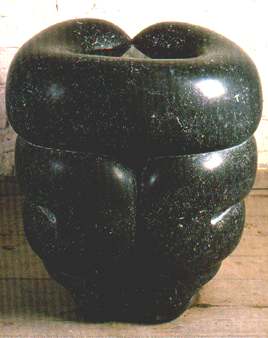
Font, 1991
Kilkenny limestone, water and gilded pebble, 94.7 x 82.4 x 73.4 cm
by Peter Randall-Page, U.K.,
|
Blessed is the spot, and the house,
and the place, and the city,
and the heart, and the mountain,
and the refuge, and the cave,
and the valley, and the land,
and the sea, and the island,
and the meadow where mention
of God hath been made,
and His praise glorified
This uncanny resemblance is in all likelihood a mere coincidence, but it highlights the essential poetic or literary quality of the prayers, letters, treatises and books written by Mirzâ Husayn-`Alî Nûrî (1817-92), known to history as Bahá’u’lláh. Bahá'ís, of course, believe that Baha’u’lláh was a Manifestation (zuhûr), or major prophet, of God and that the corpus of his writings constitute a Revelation (wahy) from God. Among the community of his followers, this speech is endowed with supernatural qualities and therefore enjoys sacred status as scripture. Nevertheless, there is the recognition that the Manifestation must pour divine truth into a particular form, shaped by the vessel of language in which it is contained, which in the case of Bahá’u’lláh's scripture happens to be Arabic and Persian. This paper will attempt to uncover some of the particular literary models which Bahá’u’lláh has chosen as the frame of expression for his revelation or scripture.
Scripture versus literature
Christians have worried for several centuries about the relationship between pagan literature and scripture and the confluence of both the Jewish and the pagan Hellenistic traditions in the formation of Christian culture. Konrad of Hirsau, who died about 1150 A.D., recounts that a pupil once asked a teacher to prove that it is not harmful to study the pagan Latin and Greek authors and poets, whereupon the teacher replied:
Would you reject the writings of Moses and the Prophets because in places they borrow words and expressions from pagan writers? Have I not already told you that all that is true that has ever been said by any human beings or all that is correct that has ever been thought has come from Him Who created us?
In the Islamic context, the doctrine of the inimitability of the Koran (i`jâz al-Qur'ân), began to take shape in the 10th century A.D., with Arab theologians and rhetoricians holding to the notion that the Koran itself was a miracle, either because of its contents or because God prevented Muhammad's contemporaries from composing a stylistically similar work. Indeed, the word âyat, or verse of scripture, is the same word as that used for a divine sign or miracle. The Koran came to be seen as an uncreated work, the exact words of which were recorded in a heavenly tablet (lawh mahf z), which was so lofty in its phrasing and its content that
mere mortals could not imitate it. There is some justification for this view in the Koran itself, but it seems clear that Muhammad himself recognized the roots of his rhyming prose style (saj`) in the prognostications of sooth-sayers (kâhin, kuhhân) and the considerable body of stories about Moses, Abraham, Jesus and the other Semitic prophets from Biblical and Midrashic sources and from Arab folklore. The particular form and expression of the truths of the Koran, therefore, is indebted to the literary milieu in which it was revealed, though Muhammad frequently points out that the revelation of the Koran is not to be confused with the mere speech of poets, soothsayers and storytellers.
In the Bahá'í context, we do not find exact parallel to the doctrine of the inimitablity of the Koran...
|
pages 22 - 23
War in the eyes of contemporary Ugandan artists
by Philip Kwesiga, Uganda.
|
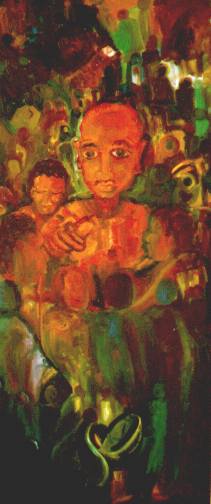
War Child
1998, oil on canvas,
100 x 210 cm.
by Philip Kwesiga, Uganda.
|
The founder of the Makerere Art School, Margaret Trowell, found that many of the students lived with a sense of strain
and anxiety about their work with no sense of economic or academic security (Bunsen, 1958).
In an attempt to remedy this, the Uganda National Cultural Policy established that artistic and intellectual creation,
which contributes to the development of societies, should be encouraged and strengthened, with attention given to
plastic arts, crafts, design and architecture, and performing arts (1998).
As evidenced in the Platinum Jubilee Art Exhibition at the Makerere Art Gallery in 1997, the pre-independence of
Uganda was a main theme, in the political, magical and religious subject matter. Though most contemporary art in
Uganda can be attributed to the formation of the art school, many of the core elements of Ugandan art were
established by the various religions' missionaries, especially Christian. It is worth noting also that when the art
school was opened, it shared premises with the Uganda Museum, which had been shifted from old Kampala hill to
Makerere hill. The director of the Museum was also the head of the art school.
Paintings such as "The Rocket Furnace" and "The Crush" (plane) by Mubitani (born 1963) illustrate new technologies in
the wrong places. The attempt to depict Ugandan martyrs contained both religious and political paradigms.
"The arrest of Joshua Nkomo" by Aaron Mubtana (1963) had a strong story to tell about peace and independence in Africa.
Before independence, Uganda was divided into small states, which were headed by kings and chiefs in some areas.
The main kingdoms were Buganda, Bunyoro, Ankole, Kooki, Tooro to mention some, and the Acholi, Lugbara, Teso, Langi
and Soga had chiefs as their head too. These various kingdoms were constantly trying to determine who was supreme over
the other. The Chwezi kingdom is believed to have been the largest of its time (1130AD). The most prominent of the wars
was the Bunyoro-Kitara in 1898, the World War II in 1939-45 and recent ones like Kabka crisis in 1966. The 1979 Amin war
and 1981-86 Museveni war.(The war raged for 5 years before the 1986 takeover).
|
All these wars have devastated the economy
of Uganda. During the Museveni era, war has continued in the northern part of Uganda and with instability in the East
(1995) and recently the devastation in Western Uganda especially in Kasese.
With all these periods and occurances a record of works in paintings, sculpture, prints have been created by artists
in Makerere University and around the country. These records are evident in murals made every year by students at
higher institutions.
Much has been talked about war and its misfortunes. Most art can only be made when there is peace in the mind, the
environment and in the audience. According to some literature, there is continued encounter of non-existence of art
in East Africa. Taken at its first meaning, discovery meant and still means the primary violence (Mudimbe, 1994).
This can only mean that Africa was discovered in the fifteenth century (East African Art has had very little exposure
from both with in and out. The only references made of African art is the cave paintings, and more on the masks and
ritual art which did not feature much in East Africa and Uganda in particular). Most of the available literature
on Sub-Saharan Africa is from West Africa, the Congo and stone curving in Zimbabwe...
|
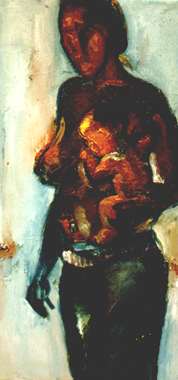
Mother and Child,
1998, oil on canvas,
42 x 71 cm high.
by George Kyeyune,
Uganda.
|
page 23
All together now: Liturgical refrains in Bahá'í Worship
by R.Jackson Armstrong-Ingram, U.S.A.
The translation of the "Song of the Holy Mariner" was published in the May 17 1922 (Azamat, 78, Vol 13, no 4) issue of Star of the West pp. 75-77. The text is preceded by a note as follows:
Note the following instruction given by Shoghi Effendi: "Where the asterisks ( *** ) are placed the following chorus or burden of the song is every time repeated: 'Glorified be my Lord, the All-Glorious!' After the last three verses of the song the chorus is as follows: 'Glorifed be our Lord, the Most High!' " {Emphasis added)
This wording clearly implies that Shoghi Effendi conceives of this as a 'performance' text. I do not discuss this text
in my book, "Music, Devotions and the Mashriqu’l-Adhkár" (Kalimat 1987).
There I discuss the Lawh-i-Naqus in the brief section where I recount the exposure to, and use of, the Eastern Bahá’í
devotional tradition by Western Bahá’ís before discussing the main topic of the book: the development of Western practices.
Of the various Bahá’í texts in this form, the Lawh-i-Naqus seems to be the one to which Western Bahá’ís had most exposure.
Indeed, it would seem that even on the first pilgrimage (1898-9) Bahiyyih Khanum taught the refrain to some of the young women who visited Akka. This might suggest that both this text, and the form it represents, had a particular resonance for Bahá’í practice in the Holy Land at that time.
|
Obviously, the problem with such a form is that someone with good enough knowledge of language and cantillation is needed for the verse part. Except for possibly some of the meetings arranged by Fareed around 1906, this was probably not often available to the Western community. However, I do think there was likely some use of the refrain as a 'free-standing' devotional practice. After all, the Western community did have a tune for the Arabic text of 'The Remover of Difficulties' at this time and this seems to have been widely used. The refrain from the Lawh-i-Naqus would be even easier to learn and, like 'The Remover..,' could be repeated a number of times. There does seem to have been a small, but appreciated, repertoire of sung short original texts available to the early Western Bahá’í community. But a verse/refrain text that required someone who could cope with the more complex cantillation of the verses would have been beyond them...
|
Photographs and Illustrations of work by:
Alexis Hunter, U.K., Estelle Cabannes, France, Ilya Artamonov, Russia, Mary Gregory,
Finland, Saskia van Baarda, The Netherlands, Sue Norris, U.K., Philip Moore, Guyana, Barbara Nessim, U.S.A., AnKi Nilson, Faroe Islands, D.R.Y., Australia, Peter Randall-Page, U.K., George Kyeyune, Uganda,
Lloyd Lawrence, U.S.A., Philip Kwesiga, Uganda, Chen Yi, P.R. China,
Tom van Teijlingen, The Netherlands, Inge Prokot, Germany, Wim van Egmond, The Netherlands,
Matin Koree, The Netherlands, Jacqueline Wassen, The Netherlands, Pooria
Sabetazm, U.S.A., Jessy Rahman,
The Netherlands, Margaret Nagawa, Uganda / U.K., and William Brown, U.K.
Translations, editing, layout, by:
Kathleen Babb, Japan, Alison Marshall, Aotearoa / New Zealand,
Steve Marshall, Aotearoa / New Zealand, Sonja van Kerkhoff, The Netherlands.
|

Arts Dialogue, Dintel 20, NL 7333 MC, Apeldoorn, The Netherlands
http://Bahá´í-library.org/bafa email: bafa@bahai-library.com
|
|













































 Awake Dutch Bahá´í Dancegroup
Awake Dutch Bahá´í Dancegroup





 Omid Aazami is standing on the left.
Omid Aazami is standing on the left.








 email:
email: 
